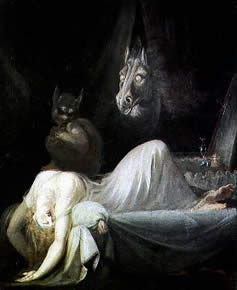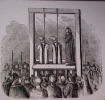The nightmare was originally defined as a feeling of suffocation or great distress felt during sleep. Many of us will have had the feeling of some heavy weight being pressed down on us, or being pinned down by an inexplicably frightening force while being unable to move. Some physical explanations have been put forward for this, yet none of them are particularly conclusive. In the past, presenting the nightmare as a living entity was not uncommon. It was sometimes referred to as the ‘night hag’ or the ‘riding of the witch’. One medieval definition of the word ‘mare’ is, in fact, ‘hag’. The Grimm brothers refer to it as a traveller in physical form, and speak frequently of shepherds observing a nightmare regularly crossing a river in a boat. The shepherds stole the boat, leaving the nightmare stranded on the other bank. The creature was thereby reduced to pitiful wailing, demanding that the boat be returned.
The Incubus
 Nightmares and incubi are said to be synonymous. The nightmare was an evil spirit and so was the incubus. The incubus, however, has strong sexual associations. It was presumed to be male (succubus is the female). The incubus was believed to settle on women to have sex with them while they slept, and was even credited with the power to make them pregnant.
Nightmares and incubi are said to be synonymous. The nightmare was an evil spirit and so was the incubus. The incubus, however, has strong sexual associations. It was presumed to be male (succubus is the female). The incubus was believed to settle on women to have sex with them while they slept, and was even credited with the power to make them pregnant.
 Many people have frightening or bad dreams from time to time, but the level of stress cause can vary from person to person. For some, the sensation of suffocating or being pressed down upon is so oppressive that there is a feeling of being taken over or possessed. These incubus experiences provide forceful material for much of the psychological horror in film such as ‘The Exorcist’. Yet on waking we are more likely to think that our dream was like the film rather than admit that the film may be based on dream like elements and experiences such as our own.
Many people have frightening or bad dreams from time to time, but the level of stress cause can vary from person to person. For some, the sensation of suffocating or being pressed down upon is so oppressive that there is a feeling of being taken over or possessed. These incubus experiences provide forceful material for much of the psychological horror in film such as ‘The Exorcist’. Yet on waking we are more likely to think that our dream was like the film rather than admit that the film may be based on dream like elements and experiences such as our own.
The Swiss artist Fuseli is said to have eaten raw beef and pork chops before going to bed so that he would have gruesome dreams to inspire his nightmarish paintings. In his best known painting ‘The Nightmare’, he depicts the subject of the title as a ghoulish horse-like creature.
Mary Shelly’s Frankenstein (1831) was conceived in what she called a half-waking nightmare. ‘I saw – with eyes shut, but with acute mental vision – I saw the pale student of unhallowed arts kneeling beside the thing he had put together.’ A bad dream usually causes us to wake up, yet she maintains she had not fallen asleep. But dream or vision, it was auspicious, as she, Shelley and Byron had each undertaken to write a ghost story. ‘What terrified me will terrify others; and I need only describe the spectre which had haunted my midnight pillow.’
Children’s Bad Dreams
Nightmares are not uncommon in our formative years; most children grow out of them. Night terrors usually occur in early childhood and rarely last beyond puberty. Night terrors differ from nightmares in that they usually occur within a couple of hours after going to bed, and the child does not immediately awake from them. When the child does awake, she or he may be screaming, disoriented and quite unable to explain what is so frightening. Parents will understandably find this disturbing, as it is difficult to reassure a small child without knowing the cause of the scare. But, of course, reassurance and comfort are required in the utmost. Nightmares, however, wake the dreamer and stay clearly in the mind. Children will often wake up crying, and talking about the bad dreams can be good for them. Sleepwalking also occurs with some children, and although this is worrying to the parents the children nearly always grow out of it and medical attention is seldom needed.
 A fear of the dark may cause frightening dreams in which the child is locked in an unlit room with an unidentifiable monster. Nightmares in which people turn into attacking demons and monsters may suggest issues with the child’s self-image. Animal nightmares, like being attacked by a wild bull for instance, could indicate frustration or anger. Bad dreams are often caused by stress, so it is important to take a good look at your child’s daily life. Watching TV at bedtime may be to blame. Watching scary movies prior to going to bed increases anxiety during deep-sleep dreaming.
A fear of the dark may cause frightening dreams in which the child is locked in an unlit room with an unidentifiable monster. Nightmares in which people turn into attacking demons and monsters may suggest issues with the child’s self-image. Animal nightmares, like being attacked by a wild bull for instance, could indicate frustration or anger. Bad dreams are often caused by stress, so it is important to take a good look at your child’s daily life. Watching TV at bedtime may be to blame. Watching scary movies prior to going to bed increases anxiety during deep-sleep dreaming.
Adult’s Bad Dreams
A nightmare will wake us by its sheer horror, and the true nightmare, or ‘incubus’ experience, seldom presents an image to explain the fear. We are conscious only of something threatening us, of bearing down upon us. Psychoanalysts explain these dreams as emanating from great anxiety or sexual repression. In the deepest dream-sleep we are immobile, this has been put forward as an explanation for the sensations perceived during these bad dreams.
Bad dreams of varying degrees can be vivid enough to recur, or  they may be a one-off. But if they do not wake us up, they are not true nightmares. Frightening dreams can take various forms – being forced to commit murder, being taken to be hanged etc. Sometimes the dreams are so scary that we will wake up before the terrible deed happens. The experience will remain with us vividly, impressing on us the need to bring repressed desires and energies into consciousness, and to deal with them.
they may be a one-off. But if they do not wake us up, they are not true nightmares. Frightening dreams can take various forms – being forced to commit murder, being taken to be hanged etc. Sometimes the dreams are so scary that we will wake up before the terrible deed happens. The experience will remain with us vividly, impressing on us the need to bring repressed desires and energies into consciousness, and to deal with them.
Often the bad dream is claustrophobic, with the dreamer being threatened in a confined space or room. This is similar to the child’s monster dreams. Recent research suggest that one in sixty people have at least two frightening dreams a week that are  disturbing enough to wake them up. Laboratory test show that these dreams can be triggered by loud noises. Nightmares of pure terror may be expressed in dreams of gory deaths and graveyard ghouls, and even cannibalism. The author Gustav Flaubert dreamt of a bloody orgy on which he was the main dish, The typical prisoner nightmare, he could neither shout nor move.
disturbing enough to wake them up. Laboratory test show that these dreams can be triggered by loud noises. Nightmares of pure terror may be expressed in dreams of gory deaths and graveyard ghouls, and even cannibalism. The author Gustav Flaubert dreamt of a bloody orgy on which he was the main dish, The typical prisoner nightmare, he could neither shout nor move.
